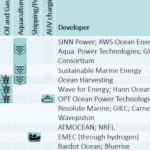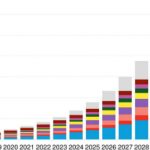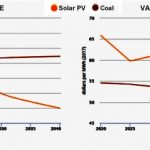Flow batteries are a promising new technology for grid storage. Rather than the standard batteries that store charge in a solid material, they use a solution to store that charge, making large-scale long-duration electricity storage much easier. Vanadium electrolytes have been the preferred choice so far, but affordable supplies are limited and a cheaper alternative will be needed for global scale-up, explains Nancy Stauffer at MIT who describes … [Read more...]
30+ nations now subsidise Heat Pumps because lifetime cost is cheaper than fossil boilers
The global growth in heat pumps can deliver almost 40% of all possible emissions cuts from heating by 2030 (with most of the rest coming from efficiency, mainly insulation), says the IEA. This is according to their “Announced Pledges Scenario” (APS) which assumes that governments carry out all of the climate commitments they have made. Keeping buildings warm produces one-tenth of global energy-related CO2 emissions. So the APS’s heat pump growth … [Read more...]
The Mining industry should simultaneously be testing for Geothermal potential
In Nevada alone, the mining industry drills over 2,000 exploration holes per year. They do so to the depths needed to also verify whether the location is suitable for geothermal energy, so it makes sense for them to assess suitability not just for minerals but for geothermal, explains Ryan Horns writing for NREL. Leveraging that data, knowledge, and expertise will expand the geothermal exploration workforce, increase the rate of geothermal … [Read more...]
Lifting and lowering tons of bricks: the best storage solution for Wind and Solar intermittency?
It’s a high capacity storage system that’s simplicity itself. Use excess wind and solar to raise heavy weights. Keep them at a height for as long as you like. Lower them to generate electricity. James Conca looks at a system being developed by Energy Vault and already being demonstrated in the Swiss national grid. At scale, a single “vault” with 10,000 bricks will have an annual output of 27 GWh, sitting on only 14 acres of land. The bricks are … [Read more...]
We’re not costing energy correctly: reward clean energy optimisation, not maximum generation
Laura Sandys at Energy Systems Catapult says policy makers today are too focussed on rewarding clean energy generation, in other words supplying as much energy as possible. With that comes a focus on reducing the cost of the energy generated. But how about reducing demand? Demand optimisation should be equally rewarded: efficiency, non-generation demand management (even at the household level: think EVs and heat pumps), and any assets that … [Read more...]
Unlocking the potential of Ocean Energy: from megawatts to gigawatts
When you consider the expanse of the world’s oceans no one should be surprised that the theoretical potential for electricity generated from ocean energy is several times total global energy demand. Of course, that potential needs to be harnessed at commercial prices. Francisco Boshell, Roland Roesch, Alessandra Salgado and Judit Hecke at IRENA run through the technologies used to extract energy from tides and waves, the potential near-term … [Read more...]
Barriers to intermittent renewables and battery storage come tumbling down
The astonishing growth of the renewable energy sector shows little sign of slowing, as costs continue to plummet, along with the cost of energy storage, to remove many of the barriers to using intermittent renewable generating sources in a range of applications. Much of this is down to the fact that the cost of battery energy storage is one third lower than this time last year. … [Read more...]
IEA: solar’s exponential growth could make it less competitive, not more
Solar’s current growth trajectory means a doubling of annual deployment every three years. But despite further expected reductions in some cost areas (e.g. cheaper tech and economies of scale), the IEA’s new VALCOE (value-adjusted levelised costs of electricity) metric calculates that solar’s relative competitiveness per unit added will actually decline as its inherent demand-matching issues scale up with the growth. Brent Wanner, WEO Energy … [Read more...]









